#Planetology
Text
Micrometeorites originating from icy celestial bodies in the outer solar system may be responsible for transporting nitrogen to the near-Earth region in the early days of our solar system. That discovery was published in Nature Astronomy by an international team of researchers, including University of Hawai'i at Mānoa scientists, led by Kyoto University.
Nitrogen compounds, such as ammonium salts, are abundant in material born in regions far from the sun, but evidence of their transport to Earth's orbital region had been poorly understood.
"Our recent findings suggest the possibility that a greater amount of nitrogen compounds than previously recognized was transported near Earth, potentially serving as building blocks for life on our planet," says Hope Ishii, study co-author and affiliate faculty at the Hawai'i Institute of Geophysics and Planetology in the UH Mānoa School of Ocean and Earth Science and Technology (SOEST).
The paper, "Influx of nitrogen-rich material from the outer Solar System indicated by iron nitride in Ryugu samples," was published in the journal Nature Astronomy.
Continue Reading.
42 notes
·
View notes
Text
Yanno what? All the other Pluto polls are painfully reductive, assigning binary positions to a more nuanced debate, so I'm gonna fix this.

#not a reblog#pluto discourse#astronomy#planetology#pluto#pluto is a planet#trans-neptunian objects#dwarf planet#planet#science
52 notes
·
View notes
Text
Watched The Way of Water at the drive-in tonight because I’m fucking sick of listening to people who treat a movie theater like it’s their private living room.
Ended up being significantly distracted anyway, because of the orbital mechanics of the Pandora system. I want to do the math on this now.
3 notes
·
View notes
Text
Is money to be gathered? cut down the pleasant trees among the houses, pull down ancient and venerable buildings for the money that a few square yards of London dirt will fetch; blacken rivers, hide the sun and poison the air with smoke and worse, and it’s nobody’s business to see to it or mend it: that is all that modern commerce, the counting-house forgetful of the workshop, will do for us herein.
Morris, 1919, l. 368, grifo nosso.
William Morris, planetologista.
1 note
·
View note
Text
Currents ... winds ... tectonic movement ... earth just loves sloshing shit around
0 notes
Photo

Stained Glass Planetology - Generative AI Art By Kyle Correia De Araujo #aiart #midjourney #art #design #creative #kylecorreiadearaujo #KyleCorreia #AI #DigitalArt #DailyArt #Arte #Artiste #ConceptArt #CreativeArt #Creativity #Imagination #Photooftheday #Artificialinspiration #GenerativeAIArt #planetology https://www.instagram.com/p/CnNM7isqHGU/?igshid=NGJjMDIxMWI=
#aiart#midjourney#art#design#creative#kylecorreiadearaujo#kylecorreia#ai#digitalart#dailyart#arte#artiste#conceptart#creativeart#creativity#imagination#photooftheday#artificialinspiration#generativeaiart#planetology
0 notes
Text
Hubble unlocks the secret of their colors
Hubble unlocks the secret of their colors
Carl Sagan and André Brahic are unfortunately no longer with us to comment on the discoveries made on the giant planets of the Solar System but their colleagues continue to explore these worlds. If the gasses that are Jupiter and Saturn are much better known to us now after the missions Juno and Cassini, the frozen ones – discovered by Herschel (Uranus) and Le Verrier (Neptune) – still hold many…
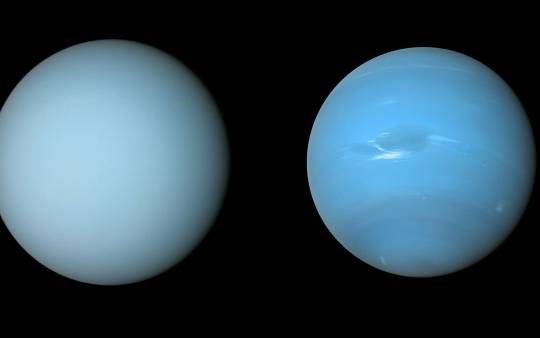
View On WordPress
#astronomy#atmosphere#climate#Earth#external geophysics#gravimetry#gravitational field#interior of the planets#internal structure#jet stream#juno#Jupiter#meteorology#Nature#Neptune#planetology#pressure#Uranus#velocity field#Voyager 2#Weizmann Institute#wind#Yohai Kaspi
0 notes
Photo

Some months ago, I created a series of maps and diagrams for @iguanodont‘s Birdbug worldbuilding project, representing the planet inhabited by their original species and its planetological data. This isn’t the first time I mapped out this planet, as I was also commissioned by Ripley back in 2020 back when I didn’t have nearly as much experience and knowledge as I do now. Two years later, I’ve been commissioned once again to revisit this world and its peculiarities.

This first map (in Equirectangular projection and poles-centered perspective) depicts the elevation for this planet, with a color gradient applied to the data.
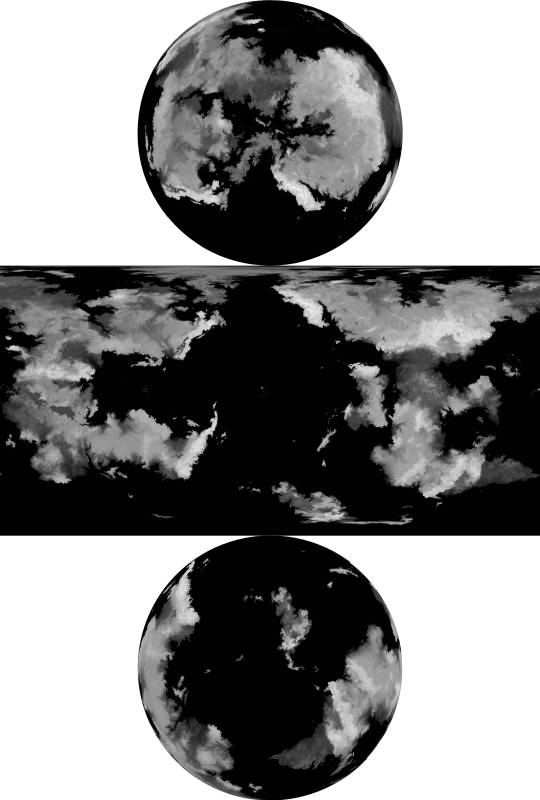
Here is the same elevation data, presented without the color gradient.
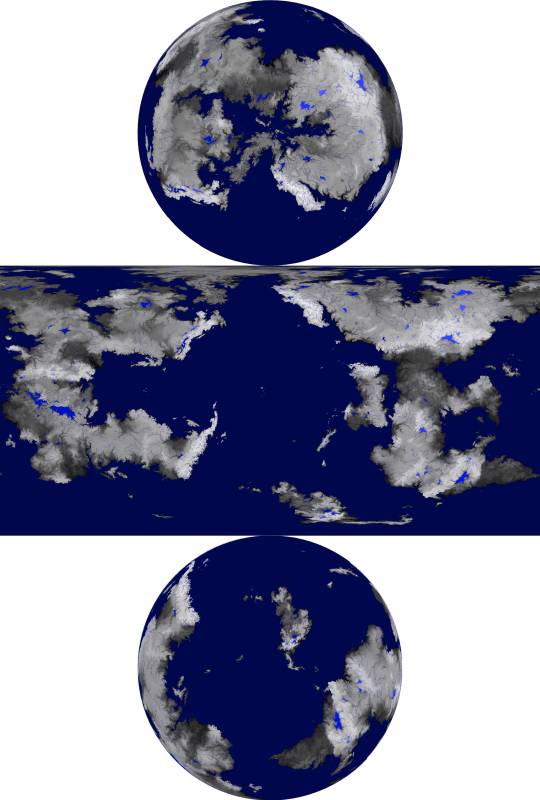
This time, the elevation is presented with bodies of liquid water included, such as rivers, oceans, and lakes.

and in this one, the water is isolated from the other data, against a white background

Next, there are the surface temperatures that occur on this planet, the key to which is shown above. The four maps below show the seasonal temperatures for land and sea, in order of Northern Spring Equinox, Northern Summer Solstice, Northern Autumn Equinox, and Northern Winter Solstice.

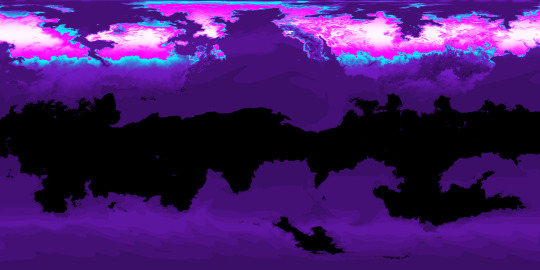
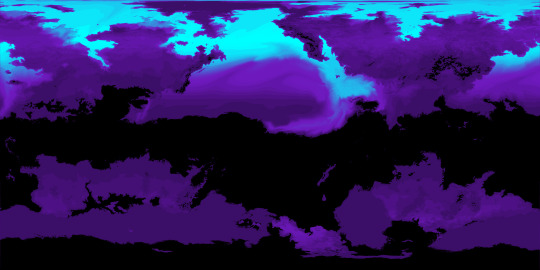

Correlating closely to the above data is the snow and ice cover, which is fairly extensive on this planet owing to its high obliquity and distance from its star. Land ice only occurs where the snow falls and is compacted year-round, but snow and sea ice can be much more seasonal.
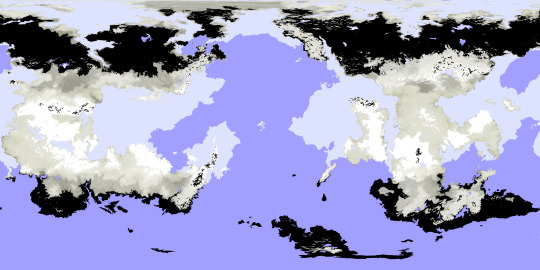
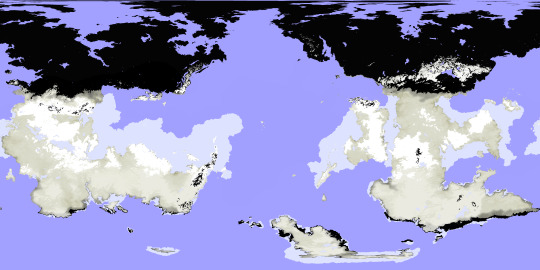
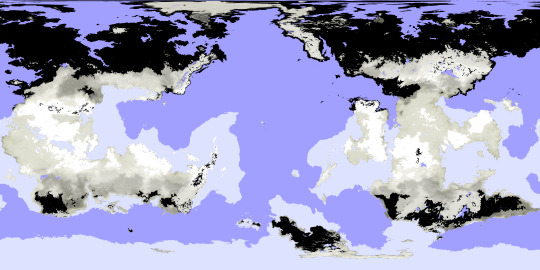
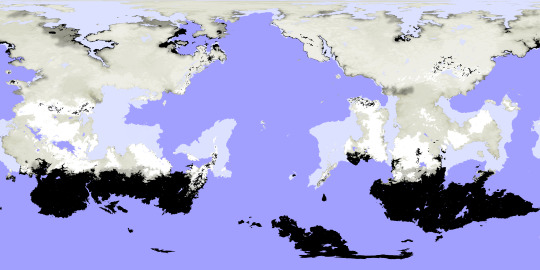
Seasonal precipitation levels were another important phase of this project, and the below diagram shows those levels for a given latitude (y-axis) on a given date (x-axis), with a key attached.
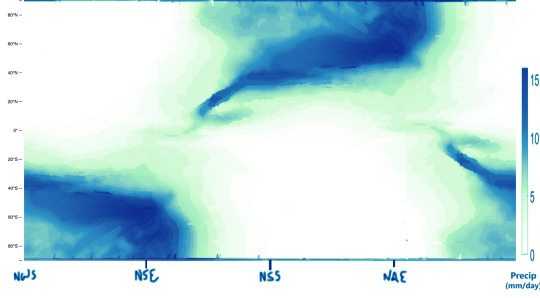
My reference for creating the above graphic is the figure below, which comes from a 2019 paper by A.H. Lobo and S. Bordoni titled “Atmospheric Dynamics of High Obliquity Planets”, and shows Earth’s precipitation levels compared to those of a planet with an 85° obliquity.

The following maps can now be better understood in light of these diagrams and keys.
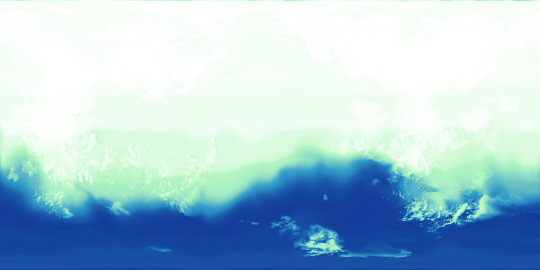
-Northern Spring Equinox
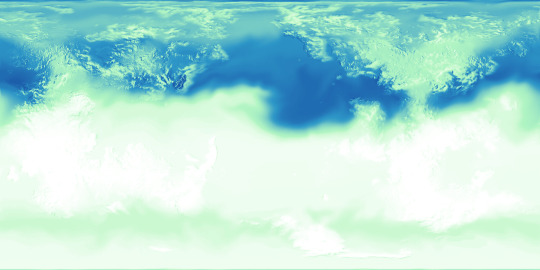
-Northern Summer Solstice
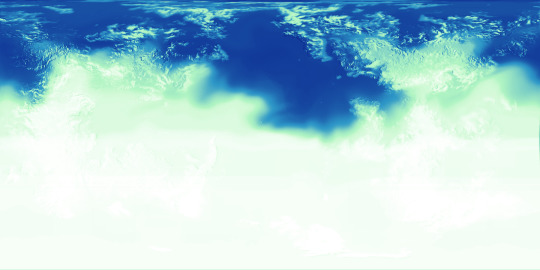
-Northern Autumn Equinox

-Northern Winter Solstice
I was also tasked with mapping out the extent and density of this planet’s vegetation (or at least its alien equivalent), and from this you can see how wildly it varies by season, with very few year-round holdings. Precipitation is a major factor in where it is possible for plants to flourish, but snow cover and the extreme temperature swings limit it too. Near either pole, for example, within the space of a year temperatures soar far above Earth’s upper limits and also plummet below freezing; if either extreme were to be the annual norm for a region, some plants might adapt to those conditions, but because of the wild fluctuation any adaptations to one extreme would leave plants especially vulnerable to the other. These regions, then, remain barren regardless of rainfall or brief windows of mild temperatures, while areas with less wide temperature ranges allow for at least brief periods of flourishing.

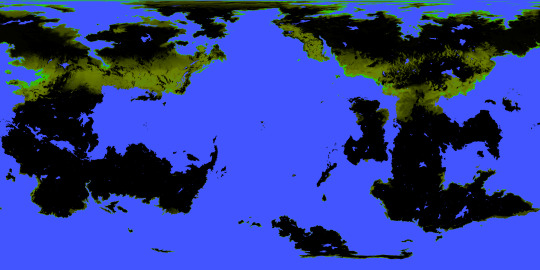
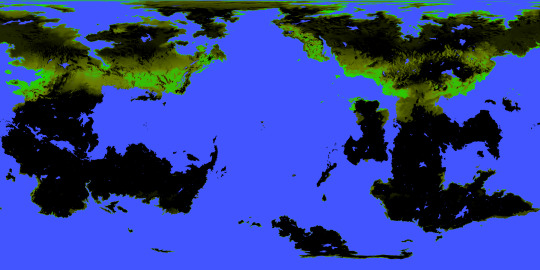
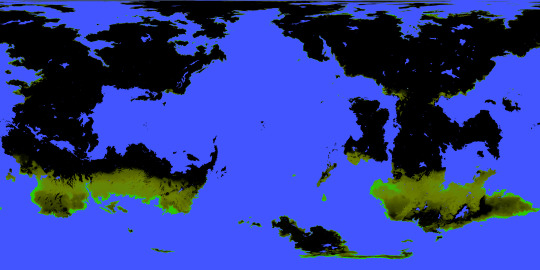
Determining the surface temperatures for this planet required a lot of background work. The first piece of the puzzle for this was knowing the number of daily hours of sunlight for a given latitude and date, which is exemplified first in this diagram for Earth:

and then for the Birdbug planet, below. Since this planet rotates on an axis of 60 degrees, there are many more latitudes within range of either pole that experience periods of sunlight and darkness lasting longer than a day. The higher the latitude, the longer this period lasts, with the poles themselves experiencing either condition for half a year at a time.

Another important factor is the height to which the sun is seen to rise (more scientifically, the angle at which the sun’s light hits parts of the planet’s surface), seen here first for Earth and then for the Birdbug planet. In these diagrams, white represents the sun reaching the zenith of the sky (meeting the surface at a 90° angle), and black represents the sun failing to appear above the horizon (meeting at an angle of 0° or below), while shades of green and purple stand in for angles between those extremes. For Earth and the Birdbug planet alike, the sun reaches the zenith within the bounds of either planet’s Tropic circles of latitude, and fails to rise at all only within the Polar circles of latitude; the difference in obliquity means that the Birdbug planet’s key circles of latitude are flipped compared to Earth’s.
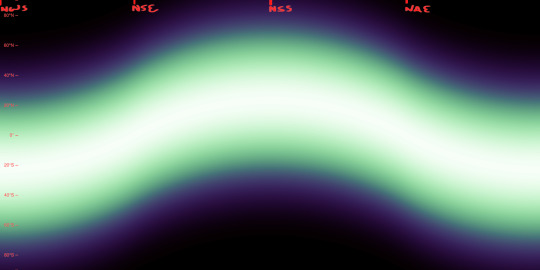
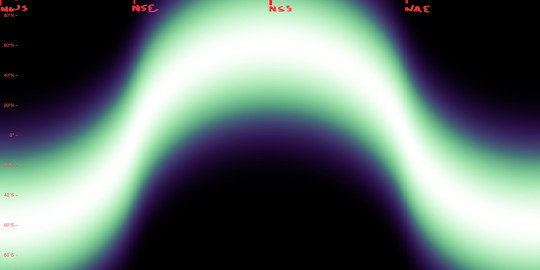
The duration of sunlight and the angle at which that sunlight is reaches the planet’s surface determine a planet’s Insolation, that is, the amount of solar energy it receives. The first image below is a preexisting diagram of Earth’s Insolation, where it is measured in watts per square meter. The next two images are my own attempts at replicating this data for Earth, and then for the Birdbug planet.

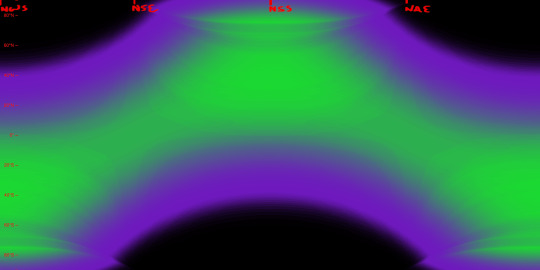
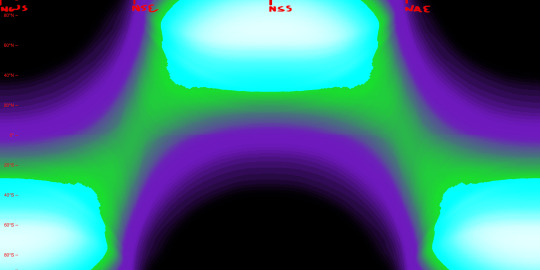
As seen in the diagrams above, Insolation on the Birdbug planet differs from Earth not only in its latitudinal distribution, but also in its sheer intensity at the higher latitudes. Compared to Earth there are twice as many latitudes for which the sun is shining longer than one rotational period, and many of those latitudes see the sun shine at a direct or nearly direct angle, whereas the Polar circles of latitude on Earth see the sun shine much more obliquely.
Below, we can see the data that all the above figures were instrumental in finding: that is, surface temperatures. The first image is a preexisting figure that measures Earth’s mean surface temperatures by date and latitude, and below that is my attempt at replicating the data by my own process.
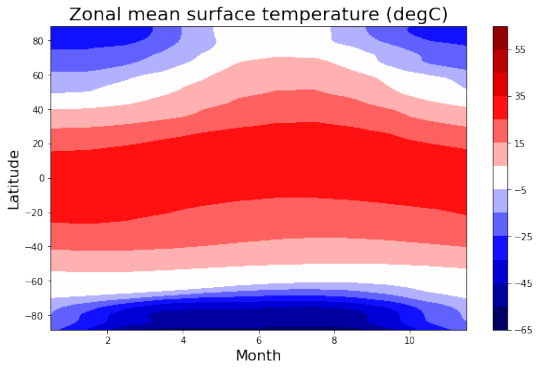
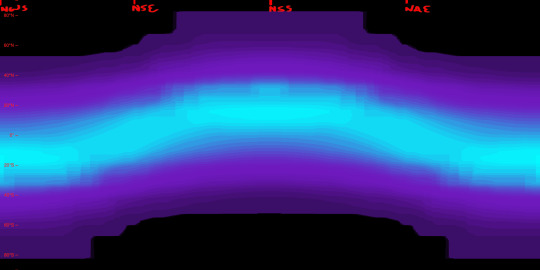
This is done not by just copying the seasonal Insolation data, but by also factoring in the yearly average for each latitude.

Above, we see the temperatures of the land by date and latitude, and below, we see the temperatures at the surface of the sea, which lag behind the land temperatures and remain comparatively mild.

Lastly, here’s an image I created to combine the snow and ice cover as well as the vegetation extent and density, as of the Northern Spring Equinox. This, along with the elevation map also seen here, is what I uploaded to maptoglobe.com in order to produce the screenshot at the top of this post.
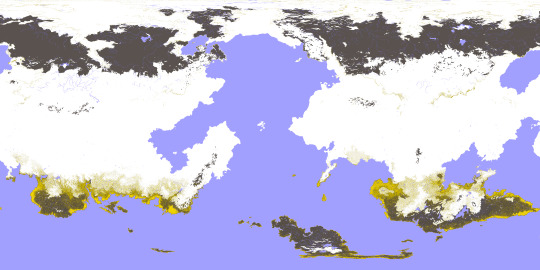
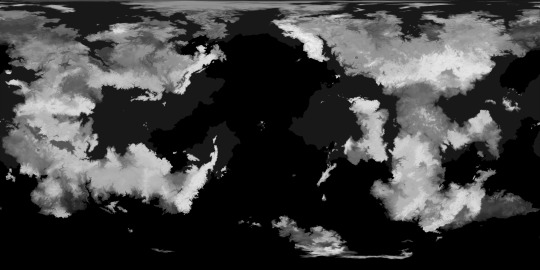
These maps and figures (except for the preexisting ones) were all created in Photopea. Higher resolution versions of many of these images can be seen in my dedicated Reddit posts, linked below:
reddit post one, reddit post two
2022
#mapmaking#imaginary maps#worldbuilding#major project#imaginary planetology#elevation#waterways#river systems#surface temperatures#ice and snow cover#sea ice#precipitation#vegetation#Insolation#high obliquity planets#explanatory diagrams#digital rendering#Photopea#Birdbug worldbuilding project#Birgs#Birgworld#2022#digital painting#extremely long post#Christopher Maida Artwork
616 notes
·
View notes
Note
do you have any posts on the landscape/wildlife of vulcan?
First off, I am so sorry that it's taken me like, NINE, months to answer this ask. Secondly, I do not know much but I can direct you to a resource that does!
Unfortunately, we only have two named and confirmed animals in main Star Trek canon, the Sehlat, and the Le-matya. There's also that freaky animal that almost kills Michael in If Memory Serves that I thought was a Le-matya but upon rewatching is definitely NOT, we have no name or information on that creature yet though. That being said, Memory Beta has a VERY thorough Vulcan Animals page from an ample supply of Star Trek novels!
Unfortunately we don't know a whole lot about Vulcans flora or fauna. If you want more information on my headcanons about the Vulcan landscape that we do know about check out The Big Vulcan Biology Post, the first half of it is primarily concerned with the hypothetical environments of T'Khasi rather than directly about Vulcans themselves.
Although a couple of new pieces of information that have come to light since I've made that post.
Discovery confirms that Vulcan has seemingly deciduous desert forests considering there were no leaves on the trees, it's dark in the flashback so it's hard to tell. I imagine Vulcan trees have red foliage, trees with red leaves or leaves that turn red in the fall do so to protect themselves from higher intensity UV rays, because our sun is closer to Earth during cold months on the northern hemisphere. Vulcan's foliage is probably red by default due to the context indicating Vulcan's sun is either bigger, or Vulcan is closer to it's sun.

The Strange New Worlds pilot shows us a Vulcan ocean (or possibly a sea)! It is very tame from what I assume is strong gravity and lack of a moon (like I mention in the BVBP). Confirming that Vulcan's oceans appear amber due to the red/orange atmosphere of Vulcan, so it's nice to know my headcanon regarding this was accurate.

I also think it's worth pointing out that Spock and T'Pring having family residences so close to such planetary rarities as forested desert areas and bodies of water is highly indicative of their families' political status.
#star trek#vulcantology#vulcan botany#vulcan zoology#vulcan planetology#vulcan anthropology#vulcan#vulcans#star trek strange new worlds#star trek discovery#if memory serves#strange new worlds (pilot)#strange new worlds#snw#st disco#star trek meta#meta#meta analysis#xenoanthropology
48 notes
·
View notes
Photo
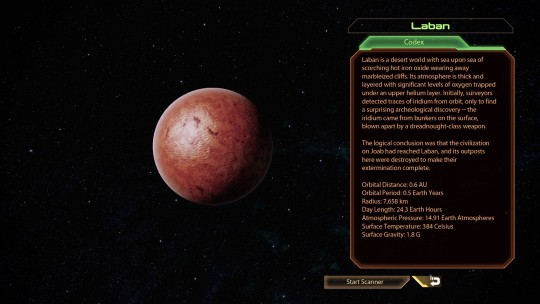
I’m back to my slow replay of Mass Effect 2 Legendary, which also means that I’m back to finding mild scientific headscratchers in the galaxy map.
It’s obvious enough what happened to Laban - I don’t think any of us will have trouble filling in the blanks here. What’s not obvious to me is the apparent stability of free oxygen at a surface temperature of 384 degrees C? Shouldn’t it be reacting with the surface rock and, well, everything, basically? Because it’s oxygen and that’s what oxygen does? Especially superheated oxygen? Also, uh, where is all this oxygen coming from? There’s no suggestion of plant life on Laban, and while photodisassociation absolutely Is A Thing, I can’t really see it operating on quite this scale?
I’m also a little puzzled by all that helium. OK, Laban has a fairly high surface gravity and in fairness I haven’t cranked the handle on the numbers to get an escape velocity out, but I have my doubts about whether a terrestrial planet is going to be able to hold a lot of helium (and if it can, why didn’t its planetary embryo turn into a gas giant during the system’s formation?).
As ever, you have to be me to be puzzling over this stuff, but this is my Tumblr, so here we go again :)
#Mass Effect#ME:LE#LHS noodles around the galaxy map#and gets diverted into headscratching about planetology#rather than actually#you know#playing the game#because that's how it goes around here#ME2
31 notes
·
View notes
Text
the german university system is actually soooo fucked up because why do i have to spend three years learning EVERYTHING about all the subtopics of my major even though i already know which subtopic i wanna focus on, and yet because of this stupid system only about 10 percent is about what i actually want to major in. like why do i have to write a. 25 page report about the rock formation of some random ass forest in germany when all i wanna do is look at the stars and analyse exoplanets. also if you fail one course three times you’re banned from that course for 10 years. i’m gonna kill myself
#10 percent if i’m lucky .#i’ve been in university for 2 years and i’ve only had two modules that had anything to do with planetology#also i might fail chemistry for a 3rd time so i literally have to go abroad to get my degree 😭 when will it endddddd#nasatalks
1 note
·
View note
Text
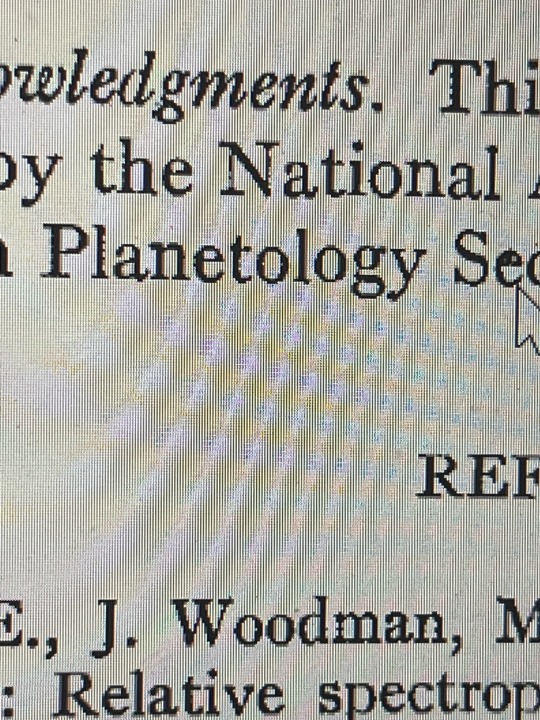
BOOOOOOO NASA USED TO HAVE A PLANETOLOGY DIVISION AND GOT RID OF IT BOOOOOOOOOOOOOOOOOOOOOOOOO
0 notes
Text
Spit on my pretty pussy
teen fuck and anal fingering (gime rico, comenten)
Rubbing my cock on my chubby sexy mature girlfriend
Les presento a mi pene
Young studs enjoy rimming and ass fucking at the tropics
Hitchhiker Slut Double Penetrated
Indian sexy babe public nude blowjob
Aura kasih
A beautiful fit Colombian pussy bulge crotch shot
Good mature hooker gets pussy drilled hard doggy style
#sprags#undisdained#Traherne#interchased#Stilu#planetologic#flunkey#siliquous#disyllabized#asphyxiative#husbanding#bludging#cock-awhoop#skys#asbestus#Yangku#Villalba#Nephtali#brass-smith#coliphage
0 notes
Text

So... Genesis, in my AGS raises the baby remnants au (I really need to come up with a shorter name), was never taken back like it happened in Crisis Core! He has just been chilling in Banora for a while, now that he was mostly cured of degradation!
He managed to access some money he had saved and paid to get a house built in Banora. He is a bit of a hermit now but he is way too focused on studying the goddess further and just overall connecting more to the planet and the lifestream. He has also written some planetology books under an alias!
#ff7#ffvii#final fantasy 7#final fantasy vii#ff7 crisis core#ff7 rebirth#sephiroth#ff7 remake#genesis rhapsodos#angeal hewley#the remnants#ff7 au#art
200 notes
·
View notes
Text
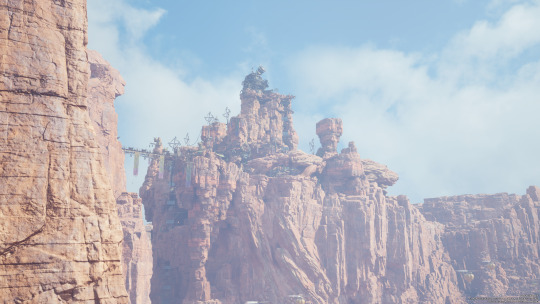
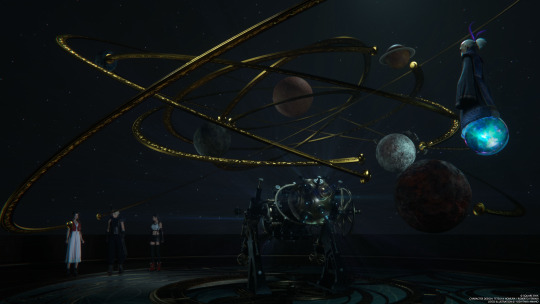


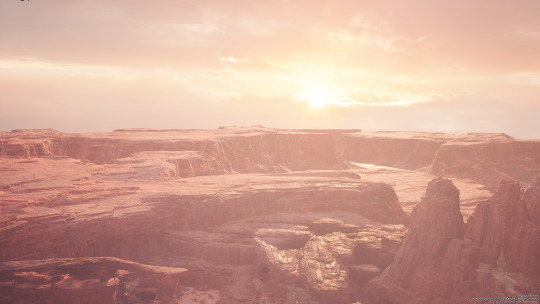




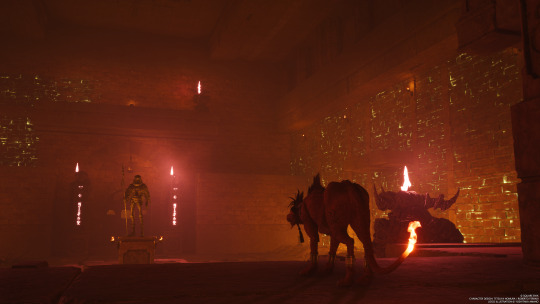
Cosmo Canyon ☀ FINAL FANTASY VII REBIRTH
The birthplace of Planetology.
—
[ screenshots free to use with credit ]
#red xiii#nanaki#cloud strife#bugenhagen#seto ff7#cosmo canyon#final fantasy vii#ffvii#final fantasy 7#ff7#final fantasy 7 rebirth#ff7 rebirth#ff7rb#ff7r#my screenshot#my edit#I gotta do another run through this area#just for photography
102 notes
·
View notes